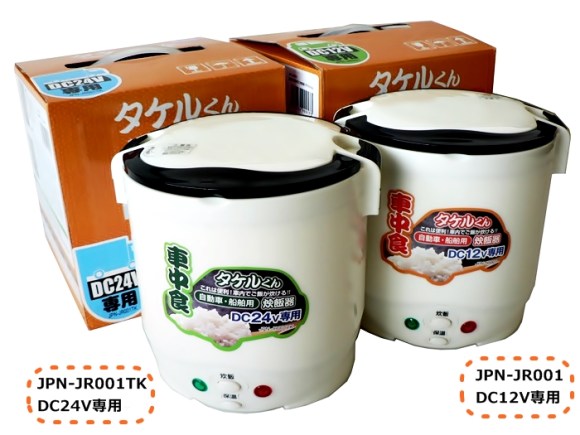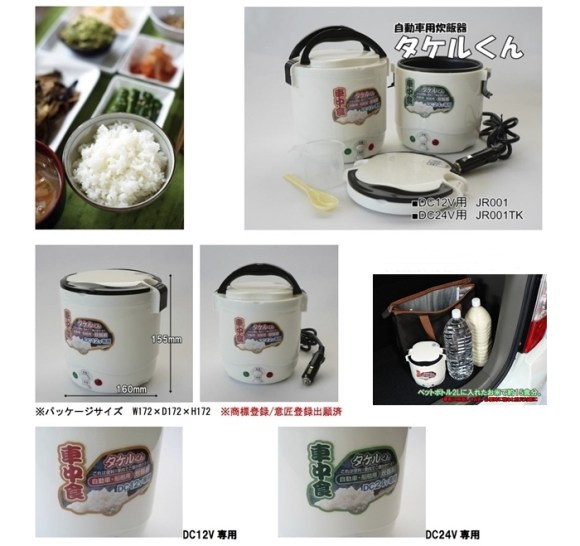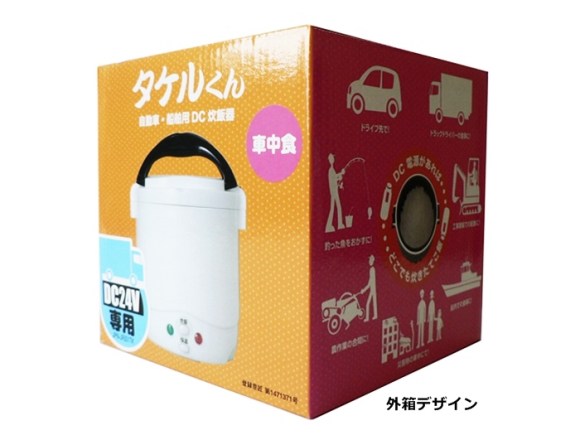
In the never-ending debate about which country makes the best cars, it’s common to derogatorily refer to a Japanese automobile as a “rice rocket,” “rice burner,” or “rice runner.” Really anything with rice.
But with a new product from Saitama-based company JPN, you can own that insult, and turn it into a positive.
JPN stands for Japan Professional Network, and befitting a company with such a vague-sounding name, it’s a little hard to find a common theme in their product line-up. Aside from interior paints and leather smartphone covers, JPN also sells car accessories such as door handle covers and cell phone chargers.
With mobile phones covered, JPN’s designers moved on to another machine near and dear to the Japanese way of life: the rice cooker.
Called Takeru-kun, JPN’s rice cooker plugs into the 12-volt electrical socket found in any passenger car. With compact dimensions of 160 mm (6.3 in) across by 155 mm (6.1 in) tall, the Takeru-kun won’t feed a whole family with one batch, but JPN claims it makes enough for two bowls of rice.
The machine isn’t any harder to use than the average suihanki rice cooker found in any Japanese home. After plugging it in, open the lid and add the rice and water. Pre-washed rice works best, of course, and JPN recommends a ratio of 1.1 parts water to one part rice. Shut the lid, hit the start button, and in about 25 minutes, the rice will done.
Although it’s technically ready to eat at that point, it’s best to let the rice sit, with the lid closed, for another 10 minutes or so. This extra steaming time will ensure that each grain is moist and fluffy, unlike the microwavable packs of rice bachelors buy from the 100-yen shop. Test testers have been fully satisfied with the results, saying that Takeru-kun’s rice comes out as tasty as the stuff they eat at home.
The standard Takeru-kun retails for 4,980 yen (US$50). A 24-volt version, usable with the larger capacity outlets on trucks and other large vehicles, is a little pricier at 5,480 yen, but cooks its rice just a little faster as well. Both models come packaged with a rice scoop.
JPN’s executive director, Nobuyuki Masuda, says the development team grappled for one year with problem of generating enough heat to properly cook rice with just 12 volts of power. Their eventual solution was to coat the Takeru-kun in insulating materials that retain as much heat as possible. This design choice has the additional benefit of helping to keep the rice warm after cooking is complete, although the machine also includes an electrically-powered function for the same purpose.
Takeru-kun is well on its way to meeting JPN’s sales target of 10,000 units in its first year. The rice cooker’s official release date was August 21, but even before that JPN had already received 3,000 preorders following the product’s announcement in June. Masuda himself was surprised by the reaction. “Honestly, we thought it would take more time for it to catch on.”
Outdoor enthusiasts are an obvious market for the product. Roasted marshmallows may be the first food that comes to mind for Americans campers, but in Japan you’re not really camping until you’ve cooked up a batch of curry, which means you’ll need some rice to go with it. Masuda says the Takeru-kun’s price point is in line with what people are willing to pay for disaster-preparedness goods as well, with some stores displaying the rice cooker alongside blankets, bottled water, and other emergency supplies.
Unfortunately, the Takeru-kun’s instructions specifically state that it is not to be used while the vehicle is in motion. This is probably for the best though, since like all rice cookers it emits a steady stream of hot vapor out of its vents while in operation, which could be just a tad distracting for motorists. So follow the directions and start your cooking after you’ve stopped your car on a flat surface. Like they say, a watched pot never boils, so we recommend using the 30 minutes or so you’ll be waiting for any of a number of traditional and necessary car-related activities, such as checking your tire pressure, reconfirming your route on the GPS, or making out in the back seat.
Sources: JPN, Nikkei Trendy Net
Images: JPN



 Japan has an awesome one-person bento box rice cooker, and here’s what we made with ours
Japan has an awesome one-person bento box rice cooker, and here’s what we made with ours Did you know your rice cooker is also a ramen rice cooker?【SoraKitchen】
Did you know your rice cooker is also a ramen rice cooker?【SoraKitchen】 Coffee-infused rice for rice balls and curry? Taste-testing a recipe from Japan’s coffee experts
Coffee-infused rice for rice balls and curry? Taste-testing a recipe from Japan’s coffee experts Japan’s one-person bento box-sized rice cooker can give you freshly cooked rice at the office
Japan’s one-person bento box-sized rice cooker can give you freshly cooked rice at the office Nametake tuna rice: A delicious rice cooker recipe using just three ingredients【SoraKitchen】
Nametake tuna rice: A delicious rice cooker recipe using just three ingredients【SoraKitchen】 McDonald’s new Happy Meals offer up cute and practical Sanrio lifestyle goods
McDonald’s new Happy Meals offer up cute and practical Sanrio lifestyle goods All-you-can-drink Starbucks and amazing views part of Tokyo’s new 170 meter-high sky lounge
All-you-can-drink Starbucks and amazing views part of Tokyo’s new 170 meter-high sky lounge Studio Ghibli glasses cases let anime characters keep an eye on your spectacles
Studio Ghibli glasses cases let anime characters keep an eye on your spectacles Super Nintendo World expansion gets delayed for several months at Universal Studios Japan
Super Nintendo World expansion gets delayed for several months at Universal Studios Japan Starbucks reopens at Shibuya Scramble Crossing with new look and design concept
Starbucks reopens at Shibuya Scramble Crossing with new look and design concept Beautiful Sailor Moon manhole cover coasters being given out for free by Tokyo tourist center
Beautiful Sailor Moon manhole cover coasters being given out for free by Tokyo tourist center More foreign tourists than ever before in history visited Japan last month
More foreign tourists than ever before in history visited Japan last month Hamster abandoned at Tokyo ramen restaurant gets new home
Hamster abandoned at Tokyo ramen restaurant gets new home The oldest tunnel in Japan is believed to be haunted, and strange things happen when we go there
The oldest tunnel in Japan is believed to be haunted, and strange things happen when we go there Arrest proves a common Japanese saying about apologies and police
Arrest proves a common Japanese saying about apologies and police Disney princesses get official manga makeovers for Manga Princess Cafe opening in Tokyo
Disney princesses get official manga makeovers for Manga Princess Cafe opening in Tokyo Beautiful new Final Fantasy T-shirt collection on the way from Uniqlo【Photos】
Beautiful new Final Fantasy T-shirt collection on the way from Uniqlo【Photos】 Is the new Shinkansen Train Desk ticket worth it?
Is the new Shinkansen Train Desk ticket worth it? Foreign English teachers in Japan pick their favorite Japanese-language phrases【Survey】
Foreign English teachers in Japan pick their favorite Japanese-language phrases【Survey】 Japanese convenience store packs a whole bento into an onigiri rice ball
Japanese convenience store packs a whole bento into an onigiri rice ball We try out “Chan Ramen”, an underground type of ramen popular in the ramen community
We try out “Chan Ramen”, an underground type of ramen popular in the ramen community Studio Ghibli releases Kiki’s Delivery Service chocolate cake pouches in Japan
Studio Ghibli releases Kiki’s Delivery Service chocolate cake pouches in Japan Japan’s bone-breaking and record-breaking roller coaster is permanently shutting down
Japan’s bone-breaking and record-breaking roller coaster is permanently shutting down New definition of “Japanese whiskey” goes into effect to prevent fakes from fooling overseas buyers
New definition of “Japanese whiskey” goes into effect to prevent fakes from fooling overseas buyers Our Japanese reporter visits Costco in the U.S., finds super American and very Japanese things
Our Japanese reporter visits Costco in the U.S., finds super American and very Japanese things Studio Ghibli unveils Mother’s Day gift set that captures the love in My Neighbour Totoro
Studio Ghibli unveils Mother’s Day gift set that captures the love in My Neighbour Totoro Foreign passenger shoves conductor on one of the last full runs for Japan’s Thunderbird train
Foreign passenger shoves conductor on one of the last full runs for Japan’s Thunderbird train Domino’s Japan now sells…pizza ears?
Domino’s Japan now sells…pizza ears? New Japanese KitKat flavour stars Sanrio characters, including Hello Kitty
New Japanese KitKat flavour stars Sanrio characters, including Hello Kitty Kyoto creates new for-tourist buses to address overtourism with higher prices, faster rides
Kyoto creates new for-tourist buses to address overtourism with higher prices, faster rides Sales of Japan’s most convenient train ticket/shopping payment cards suspended indefinitely
Sales of Japan’s most convenient train ticket/shopping payment cards suspended indefinitely Sold-out Studio Ghibli desktop humidifiers are back so Totoro can help you through the dry season
Sold-out Studio Ghibli desktop humidifiers are back so Totoro can help you through the dry season Japanese government to make first change to romanization spelling rules since the 1950s
Japanese government to make first change to romanization spelling rules since the 1950s Ghibli founders Toshio Suzuki and Hayao Miyazaki contribute to Japanese whisky Totoro label design
Ghibli founders Toshio Suzuki and Hayao Miyazaki contribute to Japanese whisky Totoro label design Doraemon found buried at sea as scene from 1993 anime becomes real life【Photos】
Doraemon found buried at sea as scene from 1993 anime becomes real life【Photos】 Tokyo’s most famous Starbucks is closed
Tokyo’s most famous Starbucks is closed One Piece characters’ nationalities revealed, but fans have mixed opinions
One Piece characters’ nationalities revealed, but fans have mixed opinions We asked a Uniqlo employee what four things we should buy and their suggestions didn’t disappoint
We asked a Uniqlo employee what four things we should buy and their suggestions didn’t disappoint Princesses, fruits, and blacksmiths: Study reveals the 30 most unusual family names in Japan
Princesses, fruits, and blacksmiths: Study reveals the 30 most unusual family names in Japan Rice cooker cooking: Bacon onion rice is amazingly easy, awesomely delicious
Rice cooker cooking: Bacon onion rice is amazingly easy, awesomely delicious Why throw away your leftover ramen broth when you can use it to make awesome ramen rice instead?
Why throw away your leftover ramen broth when you can use it to make awesome ramen rice instead? Rice cooker recipe: How to make a giant cheesy okonomiyaki pancake in a rice cooker
Rice cooker recipe: How to make a giant cheesy okonomiyaki pancake in a rice cooker How to make epic pancakes with your Japanese rice cooker
How to make epic pancakes with your Japanese rice cooker Kaki gohan – A super-easy, super-tasty rice cooker treat to make this autumn【Recipe】
Kaki gohan – A super-easy, super-tasty rice cooker treat to make this autumn【Recipe】 Carry your change in a rice cooker coin case from Japan!
Carry your change in a rice cooker coin case from Japan! Less than half of Japanese people OK with bare hand-pressed rice balls, survey says, but why?
Less than half of Japanese people OK with bare hand-pressed rice balls, survey says, but why? We turn Japanese bamboo shoot rice dish into a delectable dessert【RocketKitchen】
We turn Japanese bamboo shoot rice dish into a delectable dessert【RocketKitchen】 New Japanese bowl-shaped donburi rice cooker cooks rice and toppings at the same time
New Japanese bowl-shaped donburi rice cooker cooks rice and toppings at the same time How much more expensive is it to use microwave rice packs instead of cooking/freezing your own?
How much more expensive is it to use microwave rice packs instead of cooking/freezing your own? Cute cat-shaped food and kitchen appliances hit the gachapon capsule toy market
Cute cat-shaped food and kitchen appliances hit the gachapon capsule toy market How to cook rice in a Ziploc container【SoraKitchen】
How to cook rice in a Ziploc container【SoraKitchen】 This amazing Weipa recipe tastes every bit like fried rice without frying rice
This amazing Weipa recipe tastes every bit like fried rice without frying rice You can make rice with tapioca bubble tea, and it’s surprisingly tasty【SoraKitchen】
You can make rice with tapioca bubble tea, and it’s surprisingly tasty【SoraKitchen】 How do other flavors of ice cream rice compare to Meiji’s matcha ice cream rice recipe?
How do other flavors of ice cream rice compare to Meiji’s matcha ice cream rice recipe? Photo of “Iron Man” rice cooker look-alike spreads like wildfire on Twitter
Photo of “Iron Man” rice cooker look-alike spreads like wildfire on Twitter
Leave a Reply